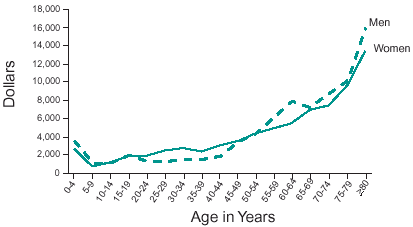
|

|

|
Leading Causes of Disability Among Persons Aged
15 Years or Older, United States, 1991–1992

Source: CDC. Prevalence of disability and
associated health conditions—United States, 1991–1992. MMWR
1994;43(40): 730–1, 737–9
(A
text description of this chart
is also available.) |
|
Costs of Chronic Disease
The United States cannot effectively address escalating health care costs
without addressing the problem of chronic diseases:
- More than 90 million Americans live with chronic illnesses.
- Chronic diseases account for 70% of all deaths in the United States.
- The medical care costs of people with chronic diseases account for
more than 75% of the nation’s $1.4 trillion medical care costs.
- Chronic diseases account for one-third of the years of potential life
lost before age 65.
- Hospitalizations for pregnancy-related complications occurring before
delivery account for more than $1 billion annually.
- The direct and indirect costs of diabetes are nearly $132 billion a
year.
- Each year, arthritis results in estimated medical care costs of more
than $22 billion, and estimated total costs (medical care and lost
productivity) of almost $82 billion.
- The estimated direct and indirect costs associated with smoking exceed
$75 billion annually.
- In 2001, approximately $300 billion was spent on all cardiovascular
diseases. Over $129 in lost productivity was due to cardiovascular
disease.
- The direct medical costs associated with physical inactivity was
nearly $76.6 billion in 2000.
- Nearly $68 billion is spent on dental services each year.
|
Estimated Per Capita Health Expenditures, by
Age and Sex, 1995

Source: From Baby Boom to Elder Boom: Providing
Health Care for an Aging Population. Copyright 1996, Watson
Wyatt Worldwide. |
|
Cost-Effectiveness of Prevention
- For every $1 spent on water fluoridation, $38 is saved in dental
restorative treatment costs.
- For a cost ranging from $1,108 to $4,542 for smoking cessation
programs, 1 quality-adjusted year of life is saved. Smoking cessation
interventions have been called the gold standard of cost-effective
interventions.
- The direct medical costs associated with physical inactivity was $29
billion in 1987 and nearly $76.6 billion in 2000. Engaging in regular
physical activity is associated with taking less medication and having
fewer hospitalizations and physician visits.
- For each $1 spent on the Safer Choice Program (a school-based HIV,
other STD, and pregnancy prevention program), about $2.65 is saved on
medical and social costs.
- For every $1 spent on preconception care programs for women with
diabetes, $1.86 can be saved by preventing birth defects among their
offspring.
- According to one Northern California study, for every $1 spent on the
Arthritis Self-Help Program, $3.42 was saved in physician visits and
hospital costs.
- A mammogram every 2 years for women aged 50–69 costs only about $9,000
per year of life saved. This cost compares favorably with other widely
used clinical preventive services.
- For the cost of 100 Papanicolaou tests for low-income elderly women,
about $5,907 and 3.7 years of life are saved.
- After controlling for physical limitation and major socioeconomic
factors, more than 12% of annual medical costs of the inactive persons
with arthritis is associated with physical inactivity. Physical activity
interventions may be a cost-effective strategy for reducing the burden of
arthritis.
Burden of Chronic Disease on Minority Racial Populations and Women
Breast and Cervical Cancer
- African American women are more likely to die of breast cancer than
are women of any other racial or ethnic group. The incidence of cervical
cancer—a 100% preventable cancer—is more than five times greater among
Vietnamese women in the United States than among white women.
Cardiovascular Disease
- More than half of persons who die each year of heart disease are
women.
- Heart disease is the leading cause of death for all racial and ethnic
groups in the United States. In 1998, rates of death from cardiovascular
disease were about 30% higher among African American adults than among
white adults.
|
Age-Adjusted Death Rates for Diseases of the
Heart* Among Women, by Race/Ethnicity,1996–1998

*Average annual deaths per 100,000 women, age
adjusted to 1940 U.S. standard population, International
Classification of Diseases, 9th Rev., codes 390–398, 402, and 404–
429.
Source: Journal of Women’s Health and Gender-Based Medicine,
Vol. 10, No. 8, 2001. pp. 717–24.
(A
text description of this
chart is also available.) |
|
Diabetes
- Diabetes affects more women than men.
- The prevalence of diabetes is 70% higher among African Americans and
nearly 100% higher among Hispanics than among whites. The prevalence of
diabetes among American Indians and Alaska Natives is more than twice that
of the total population, and the Pimas of Arizona have the highest known
prevalence of diabetes in the world.
Infant and Maternal Mortality
- African American, American Indian, and Puerto Rican infants have
higher death rates than white infants. In 1998, the death rate among
African American infants was 2.3 times greater than that among white
infants.
- African American women are four times more likely to die of
pregnancy-related complications than are white women, and American Indian
and Alaska Native women are nearly twice as likely to die.
|
U.S. Infant Mortality Rates, by
Race/Ethnicity of Mother, 1998

Source: CDC, National Center for Health
Statistics.
(A
text description of this
chart is also available.) |
|
Disability
- Life expectancy is higher for women than for men, but women older than
70 years are more likely to be disabled.
Related Information
|
|
